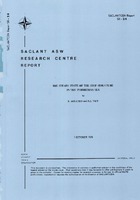| dc.description.abstract | A deep step structure, in which mixed layers alternate with high gradient interfaces, is a characteristic feature of the Tyrrhenian Sea. Three oceanographic cruises (May 1972, May 1973 and October 1974), supported by the SACLANT ASW Research Centre, allow a precise description of this phenomenon. Between 600 and 1500 m, under the maximum of temperature and salinity produced by the Levantine intermediate water, ten homogeneous layers were always found in the deepest area of the Tyrrhenian Sea. The theta-S characteristic of the ten homogeneous layers are constant to within 0.01 deg C and 0.01% from one year to another. This remarkable temporal stability of the stratification observed over 3 years modifies the common hypothesis of an isolated double diffusive system which is expected to evolve in time. | |
